After the execution of Queen Mary a great outcry
broke out over the country. In the highly charged state of public
feeling a scapegoat had to be found. The Master of Gray was exposed,
arrested and brought to trial in the Castle of Edinburgh in May
1587. He was indicted of treason under six charges in which no
mention was made of his dealing with Queen Elizabeth. He was
condemned to death but through the advocacy of his relative the Earl
of Huntly sentence was never carried out. He was banished from the
country and divested of all offices held by him.
His term of
banishment was short, for in 1589 he obtained permission from the
King to return home for a time, but while he appeared at Court he
did not regain any position or influence and he again withdrew to
the Continent. While abroad in this latter period he carried on a
correspondence with the King — preserved for us in the Moray
Papers — with a view to reinstatement in the Royal favour. In the
course of this correspondence he made pecuniary claims against the
King. These claims were finally adjusted by Commissioners appointed
for the purpose, who in 1606 found that £19,983 Scots was due by
His Majesty and an order for payment was made accordingly. Royal
favour continued to rest on him, for on his next return to Scotland,
he was connected in several more despicable actions, but in all
cases he managed to obtain a pardon from the King.
An incident very
typical of his activities took place in 1599 when Lord Balmerino
President of the Court of Session wrote to the Pope on behalf of his
cousin, Sir Edward Drummond, requesting the elevation to the
Cardinalate their kinsman, the Bishop of Vaison and containing
complimentary references to his Holiness. This letter Balmerino
managed to shuffle among other papers for the King’s signature,
and the King ignorant of its contents innocently signed it. The
Master of Gray, who was at that time in Rome, managed to get a copy
of the letter and sent it to Queen Elizabeth, who at once reproached
King James with conduct unworthy of a Protestant Prince. The King
denied all knowledge of the letter and declared it to be a forgery
by his enemies.
We come to one of the
Master’s final and meanest acts which suggest he did not restrict
his avarice to his public life. In the year 1607, one year before
his death. Lord Gray, then a very old man made complaint to the King
of his son’s behaviour. His Majesty wrote to the Council in
Scotland — "Patrick Lord Gray is havelie complenit to him
against his sone the Maister of Gray for not only having brought his
wife and familie into the said Lord’s hoose, consumed thairby all
that mean portion that he had reservit for his awne use and
intromissed with his maillis, fermes and duties, but also preising
verie unnaturallie to accelerat his faderis grey hams to the grave
with sorrow, by removal of all the auld servandis in no way gevis
the auld man ony contentment". By His Majesty’s instructions
the Lords of Council directed a commission to the Commendator of
Holyrude House to repair to Lord Gray’s house and make enquiry.
The Commendatore gave the Master fifteen days to clear out and
restore all rents, for the intromission with which he had no
warrant, under pain of the charge of Rebellion.
In 1575 he had
married Elizabeth Lyon daughter of Lord Glamis but with no heir
divorced her on 21st. May 1585. A second marriage took place
to Mary Stewart daughter of the Earl of Orkney on 25th. November
1585. By this second wife he had, Andrew his heir and six daughters
all of whom continued the family tradition of marrying well.
Periodically,
previous to Andrew the seventh Lord of Gray’s succession, various
portions of the estates had been disposed of, to raise funds in
order to provide dowries for the many daughters and to clear heavy
debts on the estate. Possibly for this reason and no doubt to escape
the distress of his father’s notoriety, he chose a military career
and became heavily engaged in the French wars. This was to be the
last chapter the Lords Gray would feature in the Castle Huntly tale,
but there is an interesting postscript. In addition to the disposal
of Castle Huntly for 40,000 marks to the first Earl of Kinghorn,
Andrew sold the Heritable Sheriffship of Forfarshire to Charles I
for 50,000 marks which were never paid.
The Lyons of Glamis (1614
to 1776)
As the Lyons of
Glamis already held lands in Longforgan and the Mains at the Castle
partly through the dower of Elizabeth, daughter of the second Lord
Gray who married John, 6th Lord Glamis in 1487, and partly through
mortgages to Patrick 9th Lord Glamis and first Earl of Kinghorne,
born 1575, the latter purchased the Castle and whole estates for
40,000 Merks in 1614.
Patrick only lived
one year after that date, but had commenced to repair the castle
which had fallen into a bad condition during the occupancy of the
last few Grays. As his grandson stated in his Book of Record:-
"It was a place of no consideration, fitt for nothing else but
as a place of refuge in time of trouble, wherein a man might make
himselfe a prisoner; and in the meantime might therein be protected
from a flying partie, but was never of any strength, or to have been
accounted a stronghold to endure a siege, or a place capable to hold
so many as with necessarie provisions could hold out long, or by
salleys to doe much prejudice to an enemie, and such houses truly
are worn quyt out of fashione, as feuds are, which is a great
happiness, the cuntrie being generally more civilized than it was of
ancient times, and my owne opinion, when troublesome times are, it
is more safe for a man to keep the feilds than to inclose himselfe
in the walls of a house, so that there is no man more against these
old fashion of tours and castles than I am and I wish everie man who
has such houses would reform them for who can delight to live in his
house as in a prisone".
Patrick married Lady
Anna Murray daughter of the Earl of Tulliebardine, died in 1615 and
was succeeded by his son John, born 1596.
John the second Earl
of Kinghorne did not distinguish himself, being considered as a weak
sort of fellow who fell under the influence of his first wife, Lady
Margaret Erskine, and that of his younger brother James Lyon of
Aldbar who embroiled him in many adventures which greatly reduced
his resources. Of John it is said that, "he came to his
inheritance the wealthiest peer in Scotland and left the
poorest". He was over obliging to his relations and friends,
taking on heavy obligations in bonds and cautions which plunged his
affairs deeply into debt. In addition, he developed a great
friendship with James Graham, Marquis of Montrose. Montrose was at
first a fierce Covenanter but later became more of a Royalist. There
came a point when John’s conscience forced him to part company
with Montrose who changed sides and took up arms against the
Covenanters. John, who felt deserted considered that he had a moral
obligation to the Covenanters cause, and contributed towards
financing the army against his old friend Montrose, in the process
committing himself to crippling debt.
He did, however,
continue the work of restoration of Castle Huntly. His son crediting
him with "an inteer new roofe upon the castle, which beforehand
had ane scurvie battlement".
His first wife
Margaret Erskine was the daughter of the Earl of Mar and his second
Elizabeth daughter of the Earl of Panmure. He died of the plague at
St Andrews on 12th. May 1646 where he had gone to nurse his ward,
the Earl of Errol and was succeeded by his only son Patrick, born
29th. May 1642 and by then only four years of age.
Patrick the third
Earl of Strathmore and Kinghorne grew up to be one of the most
remarkable members of the Lyon family. He was a man of extremely
fine character with strong determination to do the right by his
family and estates and was gifted with an exceptional administrative
ability.
The long period of
dissentions and unrest that affected Scotland for thirty years
preceding the Restoration told severely on the estates. Both his
grandfather and his father had been compelled to raise large sums of
money for the exigencies of war by borrowing upon the security of
their properties. Most lands were pledged in some form to creditors
throughout the land. The Castle of Glamis was denuded of furniture
and allowed to get into a state of disrepair and Castle Huntly was
almost uninhabitable. Thus when Earl Patrick came into his
inheritance, it was to shoulder a heavy burden with debts about
£40,000, an enormous sum in these days.
The young Earl’s
guardian was unwilling to undertake the rescue of a property so
deeply involved. He was advised that his estates were irrecoverable,
but his uncle, the Earl of Panmure did much to preserve a remnant
sufficient to start him in life, though quite inadequate to his rank
in Society. It is testament to his tenacity that after 40 years of
hard work he once again restored his estates to solvency.
Castle Huntly had
been made the jointure house of the family and he stayed there with
his mother. In 1650 when the boy was only eight years of age his
mother was married for the second time to the Earl of Linlithgow who
treated his stepson with harsh cruelty. After his wife’s death
this Earl compelled the repayment of all monies expended by her on
the young heir out of her jointure income.
Having completed his
studies at St Andrews the young Earl returned to his castle at
Huntly in 1660, in his eighteenth year, and even at that age had
formed his resolution to restore as far as possible the honour and
estates of his family. The lamentable condition in which he found
the castle he graphically describes in the Book of Record: "I
had a verie hard beginning, there was not even a bed in the castle
and I had to borrow one from the minister at Longforgan, while I was
awaiting the arrival of my humble student’s furniture from St
Andrews." His stepfather had stripped the house of all
furniture. The barns byres and stables were empty and as he puts it
— "Att that time I was not worth a four-footed beast safe the
little dog that I keepit att and brought with me from St
Andrews." He described the pend and entry as a quagmire as was
the most part of the enclosed ground besouth it. Inside, conditions
were not much better with only bare walls.
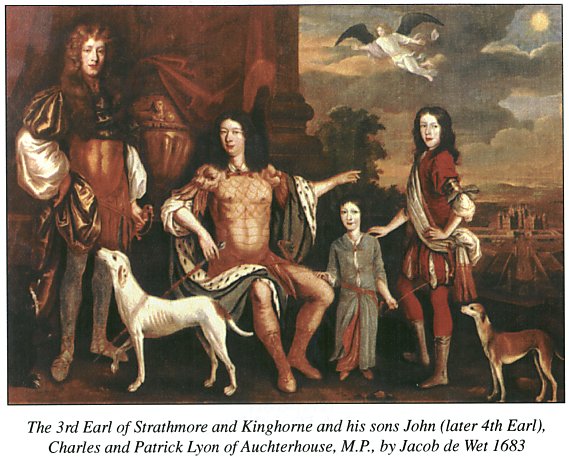
His sister Lady
Elizabeth Lyon and he began their first attempt at housekeeping on a
most parsimonious scale. Having scrambled together some old pots and
pans and collected some old furniture, they began with their own
hands to decorate their lonely dwelling and make it habitable for
the time. In the Glamis Book of Record, Patrick writes of his sister
some twenty-five years afterwards — "Her company was of great
comfort to me so young as we both were. We consulted together and in
two years got together as much coarse furniture as in a verie mean
and sober way filled all the rooms of my house some way or
other."
His sister remained
with him until his marriage in 1662 to Helen daughter of John, Lord
Middleton Royal Commissioner for Scotland. The marriage took place
at Holyrude Abbey Archbishop Sharpe officiating. In his writing 25
years later, it was considered by him to be — verie
successful.
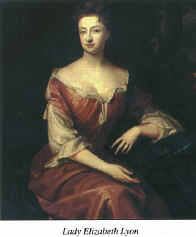 He
brought his wife home to Castle Huntly in 1663 and set about
altering and improving the buildings and policies and the status of
the family. Thus in 1672 he obtained a Charter from Charles II
erecting the lands of Castle Huntly into a free Barony to be called
the "The Lordship of Lyon", and it was then that he
changed the name to Castle Lyon. Similarly in 1677 another Charter
provided that in future the Earls of Kinghorne should be styled
"Earls of Strathmore and Kinghorne, Viscounts Lyon and Barons
Glamis, Tannadyce, Sidlaw and Strathdichtie".
He
brought his wife home to Castle Huntly in 1663 and set about
altering and improving the buildings and policies and the status of
the family. Thus in 1672 he obtained a Charter from Charles II
erecting the lands of Castle Huntly into a free Barony to be called
the "The Lordship of Lyon", and it was then that he
changed the name to Castle Lyon. Similarly in 1677 another Charter
provided that in future the Earls of Kinghorne should be styled
"Earls of Strathmore and Kinghorne, Viscounts Lyon and Barons
Glamis, Tannadyce, Sidlaw and Strathdichtie".
He was a nobleman who
shone as a patron of the arts and devoted his life to improving and
beautifying his domains. He was a Privy Councillor and Lord of the
Treasury and in 1686 an Extraordinary Senator of the College of
Justice. The entries in his Book of Record show that he was a master
of finance. At the time of his death in 1695 in his 53rd year he had
cleared most of the debt on his estates and had made considerable
alterations and additions to his castle at Glamis as well as at
Castle Lyon.
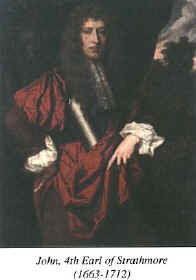 His
two daughters both married members of the local nobility and his
eldest son John, born 1663, succeeded as fourth Earl of Strathmore.
His
two daughters both married members of the local nobility and his
eldest son John, born 1663, succeeded as fourth Earl of Strathmore.
The fourth Earl,
though a man of considerable talent and a Privy Councillor in the
reign of Queen Anne took relatively little part in public affairs.
By his marriage with Lady Elizabeth Stanhope daughter of the Earl of
Chesterfield he had six sons. Two of whom became Lord Glamis, both
predeceasing their father, and four other brothers who succeeded to
the Earldom in turn, the eighth Earl and youngest son being the only
one who had an heir.
John the third son
and fifth Earl was to display the family’s royalist sympathies
when he joined the Jacobite cause, and on the breaking out of the
Mar rebellion, although only eighteen years of age, raised a
regiment in Angus and took an active part in the campaign. He was
slain at the battle of Sheriffmuir in 1715.
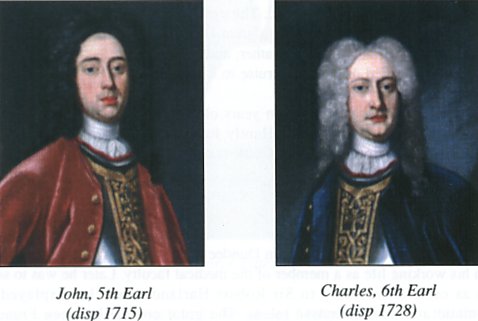
Charles, the fourth son
and sixth Earl was not directly implicated in the rebellion and
although both his family seats were visited by the Old Pretender,
James VIII and III he was not disturbed in his rights. In 1725 he
married Lady Susan Cochrane daughter of John Earl of Dundonald who
was considered to be the most beautiful woman of her day in
Scotland. Earl Charles was killed in an unfortunate brawl at Forfar
by Carnegie of Finavon in May 1728 and left no heir.
James the next in
succession died without issue in 1735.
Thomas was the last
of the four brothers. Notwithstanding the Jacobite antecedents of
his family he refrained from that cause in 1745. For a time he was
MP for Angus. He died in 1753. His son John succeeded.
In general these
later Earls lie outside our immediate theme for Castle Huntly being
the jointure house was mostly occupied by the widows of various
Earls. Thus Lady Susan the widow of Charles sixth Earl resided at
Castle Huntly for seventeen years after her husband’s death in
1728. Later she made an unfortunate second marriage and left for the
Continent where she died in 1754.
The ninth and tenth
Earls must be mentioned, partly because of a marriage which was
destined to have an historic outcome and partly because with the
tenth Earl the family link with Castle Huntly ceased. John the ninth
Earl of Strathmore was only sixteen when he succeeded. Thirteen
years later, in 1767 he married Miss Mary Eleanor Bowes of Streatham,
a great Durham heiress, who inherited a large fortune and great
estates from her father, and with this John assumed the name of
Bowes Lyon. He died on a health cruise to Lisbon in 1776 leaving
three sons and two daughters.
The heir another John
was seven years old at his father’s death. He can have known
little or nothing of Castle Huntly for his mother Countess Bowes
Lyon removed at once to London and the Castle and its estates were
sold.
The Patersons
(1777-1946)
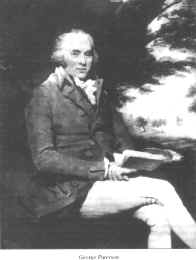 George
Paterson, who was born in Dundee in 1734 and having studied medicine
began his working life as a member of the medical faculty. Later he
was to serve in India as official secretary to Sir Robert Harland
where he displayed great diplomatic and administrative talent. The
great contest between France and England for supremacy in Hindustan
was then at its peak, and the victories of Clive over Dupleix were
looked upon, even by British statesmen as merely accidental
triumphs. After Clive’s daring exploits in Ascot, where from that
spot the terror of his name was to spread across India, he placed
Mahammed Ali on the throne as Nawab. Paterson, who displayed a
considerable administrative capacity, was to support Sir Robert in
the important negotiations and diplomacy necessary in settling and
defending the Nawab of Arcot.
George
Paterson, who was born in Dundee in 1734 and having studied medicine
began his working life as a member of the medical faculty. Later he
was to serve in India as official secretary to Sir Robert Harland
where he displayed great diplomatic and administrative talent. The
great contest between France and England for supremacy in Hindustan
was then at its peak, and the victories of Clive over Dupleix were
looked upon, even by British statesmen as merely accidental
triumphs. After Clive’s daring exploits in Ascot, where from that
spot the terror of his name was to spread across India, he placed
Mahammed Ali on the throne as Nawab. Paterson, who displayed a
considerable administrative capacity, was to support Sir Robert in
the important negotiations and diplomacy necessary in settling and
defending the Nawab of Arcot.
Paterson amassed a
large fortune in the East India Company and returned to Scotland in
1776 and in the November of that year was to marry Anne, youngest
daughter of John, 12th Baron Gray. It is said that when a friend of
the family remarked to Lord Gray that he was surprised at the
engagement of his daughter to a commoner, Lord Gray replied —
"Weel, she has the bluid and he has the fillings, so between
them they will mak a guid puddin."
Paterson purchased
the Castle and estates of Castle Lyon at the price of £40,000 being
as many pounds sterling as the 40,000 merks (about £2,200) which
Earl Kinghorne paid in 1614. In honour of his wife who was a direct
descendant of the long line of Grays who had owned the castle, he
changed the name back to Castle Huntly.
When Paterson took
over the castle it was in a very dilapidated condition and the
alterations which the Lyons had made were quite out of date. He
spent vast sums of money in repairs and additions, building the fine
Georgian wings to the NE side. The Old Statistical Account records.
"The wings, embattled walls, round tower and corner turrets
were added to the original building by him and many improvements
were effected in the interior making very fashionable apartments
suitable for modern requirements."
Paterson was a man of
great ability and many interests. He was a pioneer in agriculture,
most notable for two developments. He is credited with introducing
the steam melon pit to the gardens, and in 1788 is reputed with the
inauguration of the first threshing mill in the area. He was greatly
interested in education and gave a yearly allowance of £30 to
increase the salary of the local schoolmaster to £50 per
annum; made an allowance to pay the fees of poor scholars; presented
Bibles, Testaments and prizes to poor scholars and in 1825 set up a
new school. He was good to the tenants in the village and the
workers on his estate. During the winter following the bad harvest
of 1795 he and Lord Kinnaird obtained 400 quarters of mealing oats
from England which were supplied free to the poor. His presence was
felt in Dundee where in 1775 he presented three lustres to the Town
House; in 1776 he was Master of St David’s Lodge of Freemasons at
the laying of the foundation stone of Trades Hall and in 1777 Deacon
of the Nine Trades and the Weavers.
By his marriage with
the Hon. Anne Gray he had seven sons and three daughters. He died in
1817 having reached his 83rd. year.
All of the first
laird’s sons with the exception of one who died in infancy chose
careers of adventurous activity and attained distinction in the Army
or the Navy as the following summary indicates:- George (Jan.
1778-1846) who succeeded to the estates was Colonel of the 3rd Foot
Guards and was at Waterloo; John (Dec. 1778-1858) was a Captain in
the Royal Navy; David (1781-1813) holding rank as Lt Colonel in the
53rd Rifles was Aide-de-camp to Lord Raglan during the Peninsular
War and fell in action at Vittoria; William (1783-1838) was a
Captain in the Royal Navy; James (1785-1856) was a Captain in the
service of the East India Company and spent his life where his
father had won distinction.
Colonel George
Paterson born 1778, died 1846, was laird for twenty-nine years but
spent most of his life in the Army. His son George, born 15th. June
1819 succeeded in 1846. This George Paterson after taking his degree
as M.A. was admitted, in 1842 as an advocate at the Scottish Bar. He
took a keen interest in the estate and became an authority on the
subject of Firs. His writings upon questions connected with
agriculture and the law aroused great interest and are still quoted
as authoritative. George Paterson died on 25th. February 1867.
George Frederick son
of the third laird succeeded in 1867. There is not much known about
this fourth laird as it appears that he left the district and the
Castle and policies were leased to Mr J Martin White whose family
were the Whites of Balruddery. On his death in 1890, George Fredrick
bequeathed the estates to his younger brother, Charles James George
Paterson.
In 1886 the castle
and policies were leased to Lady Annitstead who remained there until
her death in 1913. While not an owner she did a lot to improve the
castle and grounds and was responsible for the opening of the new
avenue to the main road west of the village. She maintained a large
staff at the castle and was a generous benefactress to the district.
She bore the cost of the erection of the fine church of St Columba
at Invergowrie.
Although Castle
Huntly estate was one of the richest in the carse Charles lived
principally in Palmerston Place in Edinburgh, and the castle being
let, had a cottage in Longforgan in which he stayed when visiting
the district. He died in Edinburgh on 24th. July 1937 at the age of
79, leaving practically the whole of his estate to charity, and by
his will dated December 1936, he directed the trustees to sell the
lands of Castle Huntly.
On the 18th March
1919 the whole estate including the village of Longforgan was put up
for sale in the Royal Hotel in Dundee. Previous to the sale most of
the farms and the cottages in the village were sold privately and a
large portion of land was purchased by the Board of Agriculture as a
centre for small-holdings for exservice men. The castle and policies
were put up separately and were purchased for £6,400 by an estate
agent from Edinburgh on behalf of Mr Charles Paterson the former
owner who retained them until his death in 1937.
As he had never
married he was succeeded by a distant cousin Colonel Adrian Gordon
Paterson DSO, MC. This the last laird carried out many improvements
at the castle in anticipation of taking up residence but died three
years after succeeding in 1940 having never resided in the castle
proper. His heir a young lad had been drowned in a tragic yachting
accident in the Tay and the family moved to London.
State Ownership (1946—
Present)
A new chapter was to
begin for Castle Huntly. With the outbreak of war it was sequestered
for a war residence by a Girls’ Probation School. and for a few
months was a convalescent home for War wounded. When the girls
vacated the castle in 1946 it was sold to the State by the widow of
Colonel Adrian where it was converted by the Scottish Home and
Health Department as an open Borstal for Boys, the first fifteen to
arrive on the on 21st. April 1947. Within two years Castle Huntly
was to begin its first social experiment by taking boys described as
bruisable. These were often young men who had experienced
deprivation during childhood and were suffering the physical
manifestations of such conditions. The healthy environment was seen
as an opportunity for them to develop both physically and mentally.
The rich parklands were ideal for all sorts of outdoor pursuits, as
well as for the cultivation of soft fruits and vegetables. The stout
castle, with its many rooms was found to be just as secure from the
inside, as the Grays constructed it to provide security from the
outside.
The castle with its
irregular rooms and complexity of staircases was not ideally suited
for its purpose, and by 1972, it was clear that the level of
development, necessary to comply with fire regulations was
uneconomic and impractical. The authorities took the decision, to
relocate the living accommodation down to the flat lands in the
south-west shadow of the castle. At that time an opportunity was
taken to increase the living accommodation to 144. The castle was to
retain the role of the administrative centre for the establishment.
Changing penal policy
was to see the demise of Borstal Training and in 1984 Castle Huntly
was once more at the forefront of experiment in becoming Scotland’s
only open Young Offender Institution. This was to follow similar
traditions to that of Borstal training but with more emphasis on
vocational training. A new workshop was constructed for the training
of engineering skills and trades such as car mechanics, welding and
spray painting were taught.
The hand of change,
never far from Castle Huntly, was once again to descend in 1995.
With a diminishing demand for Young Offender spaces, Castle Huntly
was to become an Open Prison for male adults (over 21) serving
sentences of up to two years. This, in effect, meant that they would
only be at Castle Huntly for a few months. There would be no fence
or wall and prisoners would be expected to act as responsible
citizens.
To date this new
venture is proving successful, with a dynamic and evolving regime
designed to meet the needs of an ever changing population. As to the
future, who can tell. All that one can say is that Castle Huntly
will perpetuate, for it is doubtful if anyone can claim ownership of
such a history. We merely hold it in trust for future generations.

